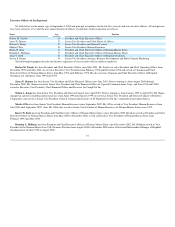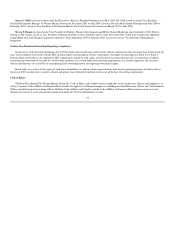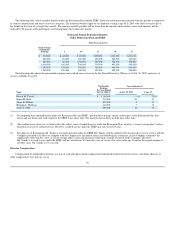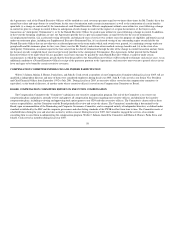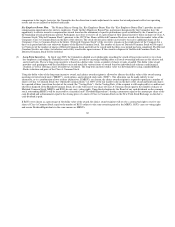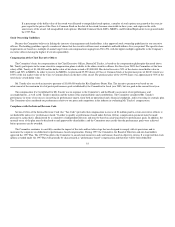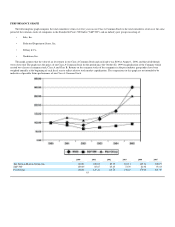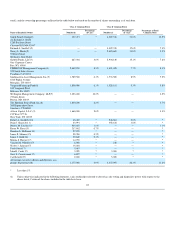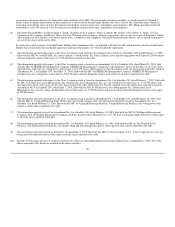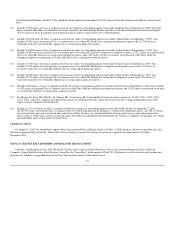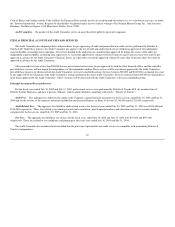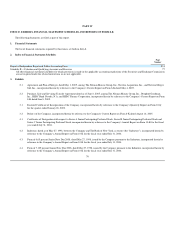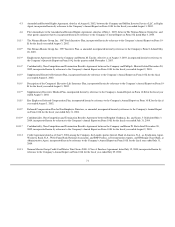Neiman Marcus 2004 Annual Report Download - page 64
Download and view the complete annual report
Please find page 64 of the 2004 Neiman Marcus annual report below. You can navigate through the pages in the report by either clicking on the pages listed below, or by using the keyword search tool below to find specific information within the annual report.
If a percentage of the dollar value of the award was allocated to nonqualified stock options, a number of stock options are granted at the exercise
price equal to the price of the Class A Common Stock on the date of the award, become exercisable in three years, and expire on the sixth
anniversary of the award. All nonqualified stock options, Matched Common Stock, RSUs, MRSUs, and Dividend Equivalents were granted under
the 1997 Plan.
Stock Ownership Guidelines
Because the Committee believes in linking the interests of management and shareholders, it has approved stock ownership guidelines for our executive
officers. The holding guidelines specify a number of shares that the executive officers must accumulate and hold within a five-year period. The specific share
requirements are based on a multiple of annual target total cash compensation ranging from 3X to 5X, with the higher multiples applicable to the Company's
executive officers having the highest levels of responsibility.
Compensation of the Chief Executive Officer
The Committee's basis for compensation of the Chief Executive Officer, Burton M. Tansky, is based on the compensation philosophy discussed above.
Mr. Tansky participates in the same executive compensation plans available to the other executive officers. For fiscal year 2005, the Committee set the base
salary of Mr. Tansky at $1,300,000 and the dollar value of his choice award at $3,000,000. He elected to receive 50% of the choice award dollar value in
RSUs and 50% in MRSUs. In order to receive the MRSUs, he purchased 29,590 shares of Class A Common Stock at the purchase price of $60.83 which was
100% of the fair market value of the Class A Common Stock on the date of the award. The purchase price of the 29,590 shares was approximately 50% of the
total choice award dollar value.
Mr. Tansky also received an incentive payment of $1,690,000 under the Key Employee Bonus Plan. The incentive payment was based on our
achievement of the maximum level of pretax performance goals established by the Committee for fiscal year 2005, but was paid in the current fiscal year.
The compensation level established for Mr. Tansky was in response to the Committee's and the Board's assessment of our performance and
accomplishments, as well as Mr. Tansky's position and the nature of his responsibilities and contributions. The Committee considered Mr. Tansky's
performance in terms of our success in meeting its performance targets, from both an operational and a financial standpoint, and in executing its strategic plan.
The Committee also considered our performance relative to our peers and competitors in the industry in evaluating Mr. Tansky's compensation.
Compliance with the Internal Revenue Code
Section 162(m) of the Internal Revenue Code (the "Tax Code") provides that compensation in excess of $1 million paid to certain executives officers is
not deductible unless it is "performance-based." In order to qualify as performance-based under Section 162(m), compensation payments must be made
pursuant to a plan that is administered by a committee of independent directors and must be based on achieving objective performance goals. In addition, the
material terms of the plan must be disclosed to and approved by shareholders, and the Committee must certify that the performance goals were achieved
before payments can be awarded.
The Committee continues to carefully consider the impact of this rule and has taken steps that are designed to comply with its provisions and to
maximize the corporate tax deduction for performance-based compensation. During 1997, the Committee, the Board of Directors and our shareholders
approved the 1997 Plan. The 1997 Plan allows the Committee to award stock incentives and cash bonuses based on objective criteria. It is expected that stock
options awarded under the 1997 Plan will generally be characterized as "performance-based" compensation and therefore will be fully deductible
61


